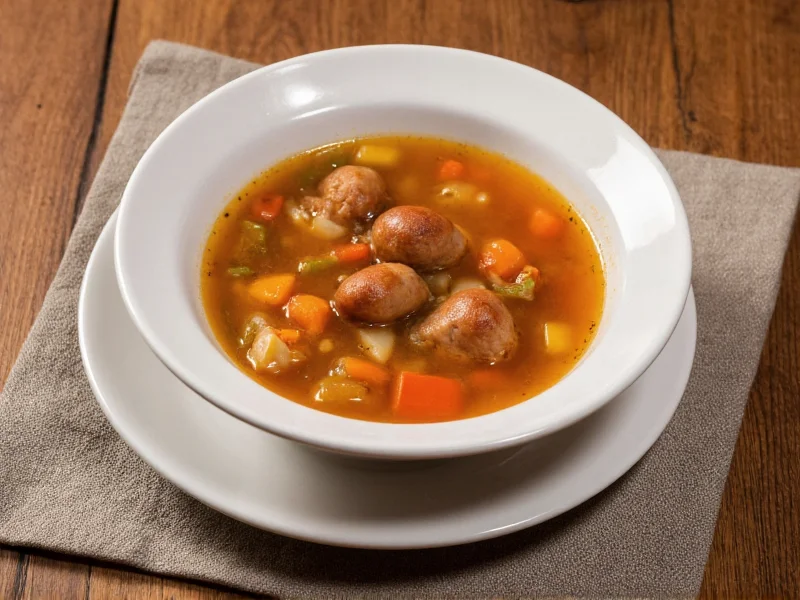When exploring soup and sausage pairings, understanding the interplay between texture, fat content, and seasoning profiles is essential for creating balanced dishes. The right sausage selection can transform a simple broth into a restaurant-quality meal while complementing rather than dominating the soup's flavor profile.
Understanding Sausage Types for Soup Applications
Sausage varieties differ significantly in preparation method, fat content, and seasoning, all of which affect their performance in soups. Fresh sausages require full cooking in the soup, while pre-cooked varieties mainly need heating through. The fat content influences the soup's richness, with higher fat sausages creating more luxurious broths.
| Sausage Type | Best Soup Pairings | Cooking Time in Soup | Flavor Contribution |
|---|---|---|---|
| Smoked Sausage | Gumbo, bean soups, collard green soup | 15-20 minutes | Earthy, smoky depth |
| Italian Sausage | Minestrone, tomato soup, white bean soup | 20-25 minutes | Garlic, fennel, red pepper notes |
| Kielbasa | Cabbage soup, potato soup, lentil soup | 15-20 minutes | Garlic, marjoram, subtle smoke |
| Chorizo | White bean soup, tomato-based soups, seafood stews | 10-15 minutes | Spicy paprika, garlic, cumin |
| Breakfast Sausage | Split pea soup, corn chowder, squash soup | 15-20 minutes | Sage, black pepper, subtle sweetness |
Mastering Soup and Sausage Integration Techniques
Professional chefs employ specific techniques when incorporating sausage into soups to maximize flavor development while maintaining proper texture. The timing of sausage addition significantly impacts the final dish. For fresh sausages, browning before adding to the soup develops complex flavors through the Maillard reaction while rendering excess fat that could make the soup greasy.
When using pre-cooked sausages like kielbasa or smoked sausage, adding them during the last 15-20 minutes of cooking preserves their texture while allowing flavors to meld. Cutting sausage into appropriate sizes matters too—thicker soups benefit from larger chunks that maintain integrity, while brothy soups work better with smaller pieces that distribute flavor evenly.
Traditional Soup and Sausage Combinations Across Cuisines
Cultures worldwide have developed signature soup and sausage pairings that showcase regional ingredients and cooking traditions. Louisiana gumbo featuring andouille sausage represents one of the most celebrated combinations, where the smoked sausage's robust flavor stands up to the dark roux and complex spice blend.
Italian cuisine offers numerous pairings, with pasta e fagioli gaining depth from Italian sausage's fennel notes. German eintopf (one-pot stew) traditionally includes weisswurst or bratwurst with root vegetables in a light broth. French cassoulet, though technically a stew, demonstrates how Toulouse sausage elevates white bean preparations with its garlicky richness.
Creating Balanced Flavor Profiles
Achieving harmony between soup and sausage requires attention to seasoning balance. Sausages often contain significant salt, so adjust additional seasoning carefully. Acidic components like tomatoes or a splash of vinegar can cut through the sausage's richness, while aromatic vegetables (mirepoix or soffritto) build flavor foundations that complement both elements.
For creamy soups, consider removing some sausage fat before adding dairy to prevent separation. In brothy soups, the sausage's natural fats enhance mouthfeel without requiring additional thickeners. The starch content of accompanying ingredients like beans or potatoes helps emulsify sausage fats into the broth for a cohesive texture.
Practical Recipe Applications
Transforming theoretical knowledge into practical meals requires understanding specific applications. For weeknight cooking, pre-cooked sausages offer convenience without sacrificing quality. When making gumbo, slice smoked sausage into half-moons and brown thoroughly before adding to the roux-based broth. In minestrone, remove Italian sausage from casings and brown in the pot before adding vegetables for maximum flavor integration.
For healthier preparations, select leaner sausage varieties and blot excess fat after browning. White bean soup with chicken apple sausage provides protein with less saturated fat, while still delivering satisfying flavor. When using spicy sausages like chorizo, balance with cooling elements such as coconut milk in certain Asian-inspired soup variations.
Storage and Reheating Considerations
Soup and sausage combinations often improve with storage as flavors meld, but proper handling ensures optimal results upon reheating. Cool soups completely before refrigerating to prevent texture degradation. When reheating, do so gently over medium-low heat to prevent the sausage from becoming tough or rubbery.
Frozen soup and sausage combinations maintain quality for up to three months. Thaw overnight in the refrigerator before reheating. Cream-based soups with sausage require special attention—reheat slowly and avoid boiling to prevent curdling, stirring frequently to maintain emulsion.
Avoiding Common Preparation Mistakes
Several pitfalls can undermine otherwise promising soup and sausage combinations. Adding sausage too early can cause it to overcook and become tough, particularly with pre-cooked varieties. Neglecting to adjust salt levels when using heavily seasoned sausages results in overly salty soups. Failing to render sufficient fat from fresh sausages creates greasy broths that lack clarity.
Another common error involves mismatching sausage intensity with soup character—using strongly smoked sausage in delicate broths overwhelms subtle flavors. Similarly, pairing sweet sausages with acidic tomato-based soups creates unbalanced flavor profiles that distract from both components.
Nutritional Considerations for Soup and Sausage Meals
While delicious, soup and sausage combinations require mindful preparation for balanced nutrition. Traditional sausages often contain significant saturated fats and sodium. Selecting leaner varieties like turkey sausage or chicken apple sausage reduces fat content while maintaining flavor. Removing sausage casings before cooking allows more fat to render out during preparation.
Incorporating ample vegetables increases fiber and nutrient density, transforming soup and sausage into complete meals. White bean and sausage soup provides protein, fiber, and complex carbohydrates when prepared with reduced-sodium broth and plenty of vegetables. For lower-sodium options, choose fresh sausages without added preservatives and control salt levels during cooking.











 浙公网安备
33010002000092号
浙公网安备
33010002000092号 浙B2-20120091-4
浙B2-20120091-4